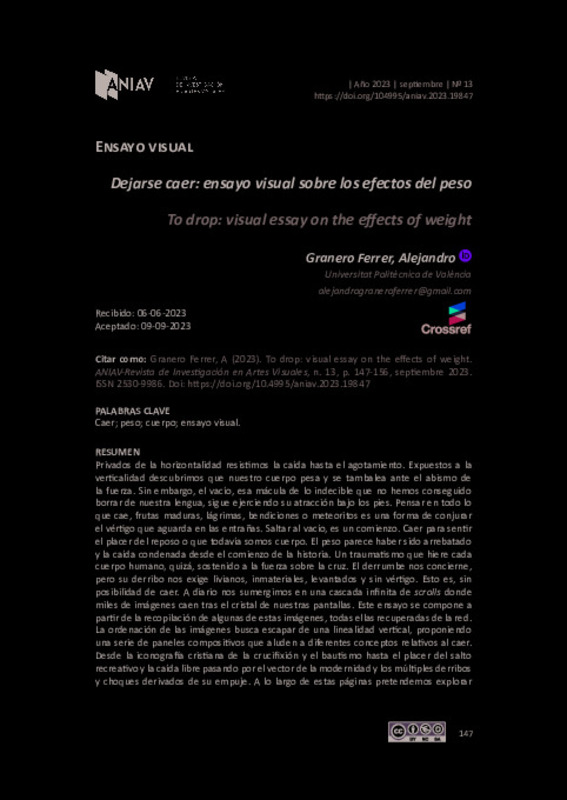JavaScript is disabled for your browser. Some features of this site may not work without it.
Buscar en RiuNet
Listar
Mi cuenta
Estadísticas
Ayuda RiuNet
Admin. UPV
Dejarse caer: ensayo visual sobre los efectos del peso
Mostrar el registro sencillo del ítem
Ficheros en el ítem
| dc.contributor.author | Granero Ferrer, Alejandro
|
es_ES |
| dc.date.accessioned | 2023-11-16T11:31:54Z | |
| dc.date.available | 2023-11-16T11:31:54Z | |
| dc.date.issued | 2023-09-29 | |
| dc.identifier.uri | http://hdl.handle.net/10251/199887 | |
| dc.description.abstract | [EN] Deprived of horizontality we resist the fall to the point of exhaustion. Exposed to verticality we discover that our body is heavy and wobbles before the abyss of force. However, the void, that stain of the unspeakable that we have not managed to erase from our language, continues to exert its attraction under our feet. Thinking of everything that falls, ripe fruit, tears, blessings or meteors is a way of conjuring up the vertigo that awaits in our guts. To jump into the void is a beginning. Falling to feel the pleasure of rest or that we are still a body. The weight seems to have been taken away and the fall condemned from the beginning of the story. A traumatism that wounds every human body, perhaps, held by force on the cross. The collapse concerns us, but its collapse requires us to be light, immaterial, lifted up and without vertigo. That is, without the possibility of falling. Every day we immerse ourselves in an infinite cascade of scrolls where thousands of images fall behind the glass of our screens. This essay is based on the compilation of some of these images, all of them recovered from the web. The arrangement of the images seeks to escape from a vertical linearity, proposing a series of compositional panels that allude to different concepts related to falling. From the Christian iconography of the crucifixion and baptism to the pleasure of recreational jumping and free fall, passing through the vector of modernity and the multiple collisions and crashes derived from its thrust. Throughout these pages we intend to explore some attempts to fall in order to discover that under the rubble there is a ground, to discover that life that pretends to be governed by force is ungovernable, to feel alive or simply to rest. To let oneself fall in order to wonder about a descent without gravity. | es_ES |
| dc.description.abstract | [ES] Privados de la horizontalidad resistimos la caída hasta el agotamiento. Expuestos a la verticalidad descubrimos que nuestro cuerpo pesa y se tambalea ante el abismo de la fuerza. Sin embargo, el vacío, esa mácula de lo indecible que no hemos conseguido borrar de nuestra lengua, sigue ejerciendo su atracción bajo los pies. Pensar en todo lo que cae, frutas maduras, lágrimas, bendiciones o meteoritos es una forma de conjurar el vértigo que aguarda en las entrañas. Saltar al vacío, es un comienzo. Caer para sentir el placer del reposo o que todavía somos cuerpo. El peso parece haber sido arrebatado y la caída condenada desde el comienzo de la historia. Un traumatismo que hiere cada cuerpo humano, quizá, sostenido a la fuerza sobre la cruz. El derrumbe nos concierne, pero su derribo nos exige livianos, inmateriales, levantados y sin vértigo. Esto es, sin posibilidad de caer. A diario nos sumergimos en una cascada infinita de scrolls donde miles de imágenes caen tras el cristal de nuestras pantallas. Este ensayo se compone a partir de la recopilación de algunas de estas imágenes, todas ellas recuperadas de la red. La ordenación de las imágenes busca escapar de una linealidad vertical, proponiendo una serie de paneles compositivos que aluden a diferentes conceptos relativos al caer. Desde la iconografía cristiana de la crucifixión y el bautismo hasta el placer del salto recreativo y la caída libre pasando por el vector de la modernidad y los múltiples derribos y choques derivados de su empuje. A lo largo de estas páginas pretendemos explorar algunas tentativas del caer para descubrir que bajo los escombros hay un suelo, para descubrir que la vida que pretende ser gobernada con la fuerza es ingobernable, para sentirse vivir o simplemente para descansar. Dejarse caer para preguntarnos por un descenso sin gravedad. | es_ES |
| dc.language | Español | es_ES |
| dc.publisher | Universitat Politècnica de València | es_ES |
| dc.relation.ispartof | ANIAV - Revista de Investigación en Artes Visuales | es_ES |
| dc.rights | Reconocimiento - No comercial - Compartir igual (by-nc-sa) | es_ES |
| dc.subject | To drop | es_ES |
| dc.subject | Weight | es_ES |
| dc.subject | Body | es_ES |
| dc.subject | Caer | es_ES |
| dc.subject | Peso | es_ES |
| dc.subject | Cuerpo | es_ES |
| dc.subject | Ensayo Visual | es_ES |
| dc.subject | Visual Essay | es_ES |
| dc.title | Dejarse caer: ensayo visual sobre los efectos del peso | es_ES |
| dc.title.alternative | To drop: visual essay on the effects of weight | es_ES |
| dc.type | Artículo | es_ES |
| dc.identifier.doi | 10.4995/aniav.2023.19847 | |
| dc.rights.accessRights | Abierto | es_ES |
| dc.contributor.affiliation | Universitat Politècnica de València. Departamento de Escultura - Departament d'Escultura | es_ES |
| dc.description.bibliographicCitation | Granero Ferrer, A. (2023). Dejarse caer: ensayo visual sobre los efectos del peso. ANIAV - Revista de Investigación en Artes Visuales. (13):147-156. https://doi.org/10.4995/aniav.2023.19847 | es_ES |
| dc.description.accrualMethod | OJS | es_ES |
| dc.relation.publisherversion | https://doi.org/10.4995/aniav.2023.19847 | es_ES |
| dc.description.upvformatpinicio | 147 | es_ES |
| dc.description.upvformatpfin | 156 | es_ES |
| dc.type.version | info:eu-repo/semantics/publishedVersion | es_ES |
| dc.description.issue | 13 | es_ES |
| dc.identifier.eissn | 2530-9986 | |
| dc.relation.pasarela | OJS\19847 | es_ES |







![HTML file [HTML]](/themes/UPV/images/html.png)

